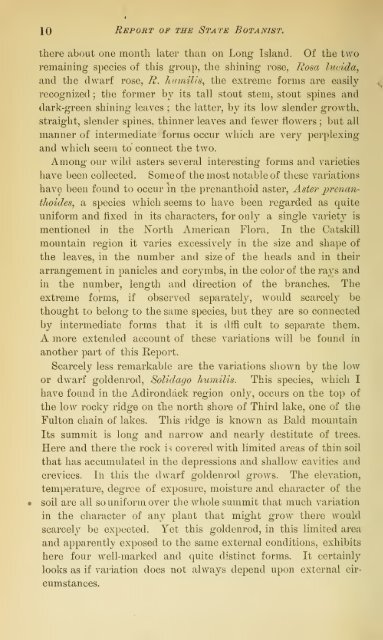Annual Report of the State Botanist 1892 - MykoWeb
Annual Report of the State Botanist 1892 - MykoWeb
Annual Report of the State Botanist 1892 - MykoWeb
Create successful ePaper yourself
Turn your PDF publications into a flip-book with our unique Google optimized e-Paper software.
10<br />
<strong>Report</strong> <strong>of</strong> <strong>the</strong> <strong>State</strong> <strong>Botanist</strong>.<br />
<strong>the</strong>re about one month later than on Long Island. Of <strong>the</strong> two<br />
remaining species <strong>of</strong> this group, <strong>the</strong> shining rose, Rosa lucida,<br />
and <strong>the</strong> dwarf rose, R. humilis^ <strong>the</strong> extreme forms are easily<br />
recognized ; <strong>the</strong> former by its tall stout stem, stout spines and<br />
dark-green shining leaves ; <strong>the</strong> latter, by its low slender growth,<br />
straight, slender spines, thinner leaves and fewer flowers ; but all<br />
manner <strong>of</strong> intermediate forms occur wliich are very perplexing<br />
and which seem to connect <strong>the</strong> two.<br />
Among our wild asters several interesting forms and varieties<br />
have been collected. Some <strong>of</strong> <strong>the</strong> most notable <strong>of</strong> <strong>the</strong>se variations<br />
have been found to occur in <strong>the</strong> prenanthoid aster, Astei' jprenan-<br />
thoides, a species which seems to have been regarded as quite<br />
uniform and fixed in its characters, for only a single variety is<br />
mentioned in <strong>the</strong> North American Flora. In <strong>the</strong> Catskill<br />
mountain region it varies excessively in <strong>the</strong> size and shape <strong>of</strong><br />
<strong>the</strong> leaves, in <strong>the</strong> number and size <strong>of</strong> <strong>the</strong> heads and in <strong>the</strong>ir<br />
arrangement in panicles and corymbs, in <strong>the</strong> color <strong>of</strong> <strong>the</strong> rays and<br />
in <strong>the</strong> nurnber, length and direction <strong>of</strong> <strong>the</strong> branches. The<br />
extreme forms, if observed separately, would scarcely be<br />
thought to belong to <strong>the</strong> same species, but <strong>the</strong>y are so connected<br />
by intermediate forms that it is dffi cult to separate <strong>the</strong>m.<br />
A more extended account <strong>of</strong> <strong>the</strong>se variations will be found in<br />
ano<strong>the</strong>r part <strong>of</strong> this <strong>Report</strong>.<br />
Scarcely less remarkable are <strong>the</strong> variations shown by <strong>the</strong> low<br />
or dwarf goldenrod, Solidago humilis. This species, which I<br />
have found in <strong>the</strong> Adirondack region only, occurs on <strong>the</strong> top <strong>of</strong><br />
<strong>the</strong> low rocky ridge on tbe north shore <strong>of</strong> Third lake, one <strong>of</strong> <strong>the</strong><br />
Fulton chain <strong>of</strong> lakes. This ridge is known as Bald mountain<br />
Its summit is long and narrow and nearly destitute <strong>of</strong> trees.<br />
Here and <strong>the</strong>re <strong>the</strong> rock is covered with limited areas <strong>of</strong> thin soil<br />
that has accumulated in <strong>the</strong> depressions and shallow cavities and<br />
crevices. In this <strong>the</strong> dwarf goldenrod grows. The elevation,<br />
temperature, degree <strong>of</strong> exposure, moisture and character <strong>of</strong> <strong>the</strong><br />
soil are all so uniform over <strong>the</strong> whole summit that much variation<br />
in <strong>the</strong> character <strong>of</strong> any plant that might grow <strong>the</strong>re would<br />
scarcely be expected. Yet this goldenrod, in this limited area<br />
and apparently exposed to <strong>the</strong> same external conditions, exhibits<br />
here four well-marked and quite distinct forms. It certainly<br />
looks as if variation does not always depend upon external cir-<br />
cumstances.
















